United States Mint Launches the American Women Quarters™ Program
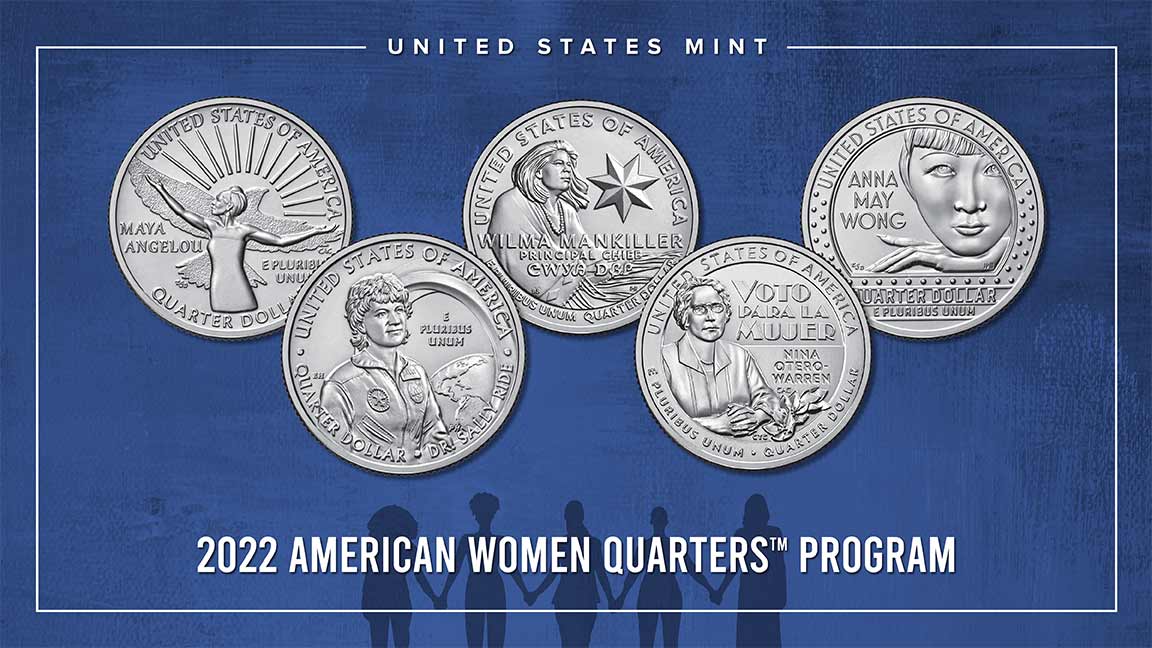
United States Mint artists face the challenge of expressing the values, aspirations, and shared heritage of our nation. Through their extraordinary, specialized artistry, they are tasked with communicating the essence and the story of America to the world on a canvas the size of a quarter.
From 2022 through 2025, the Mint will design and issue five quarters annually that feature reverse designs honoring a diverse group of women whose achievements, triumphs, and legacies reflect the strength and resilience of our nation.
Selecting the honorees is a daunting task, considering just how many courageous and trailblazing women have shaped our country’s history. The National Women’s History Museum, Smithsonian American Women’s History Initiative, and Bipartisan Women’s Caucus serve as consultants during the honoree selection process, which included sorting through the more than 11,000 public submissions received through a web portal hosted by NWHM earlier this year.
In 2022, the American Women Quarters™ (AWQ) Program will recognize the achievements of Maya Angelou, Dr. Sally Ride, Wilma Mankiller, Nina Otero-Warren, and Anna May Wong. We are pleased to share insights from Mint design management staff, Mint Medallic Artists, and Mint Artistic Infusion Program (AIP) artists who have worked tirelessly to capture the unique characters and enduring legacies of these five extraordinary women.
Maya Angelou Quarter
The first woman to be honored in the AWQ Program is writer, poet, performer, social activist, and teacher Maya Angelou. “It was a challenge to figure out a way to represent Maya Angelou, considering that her life and her contributions to American culture were so multi-faceted,” said Mint AIP Artist Emily Damstra.
Mint Design Manager Megan Sullivan, who managed the review of the candidate coin designs, notes that “[while] Maya Angelou was known for her writing, this design was an opportunity to share that she was an author and so much more.”
“Ultimately, I decided that showing her in an uplifting stance, gesturing expressively, would best convey the passionate way she lived. The bird in flight and the rising sun—imagery that she incorporated in her own writing—are also symbolic of the way she lived,” said Damstra.
Mint Medallic Artist Craig Campbell executed the sculpt for the Maya Angelou Quarter and explained, “The challenge in this piece was in communicating the subtleties that make it a beautiful monument to a beautiful soul.”
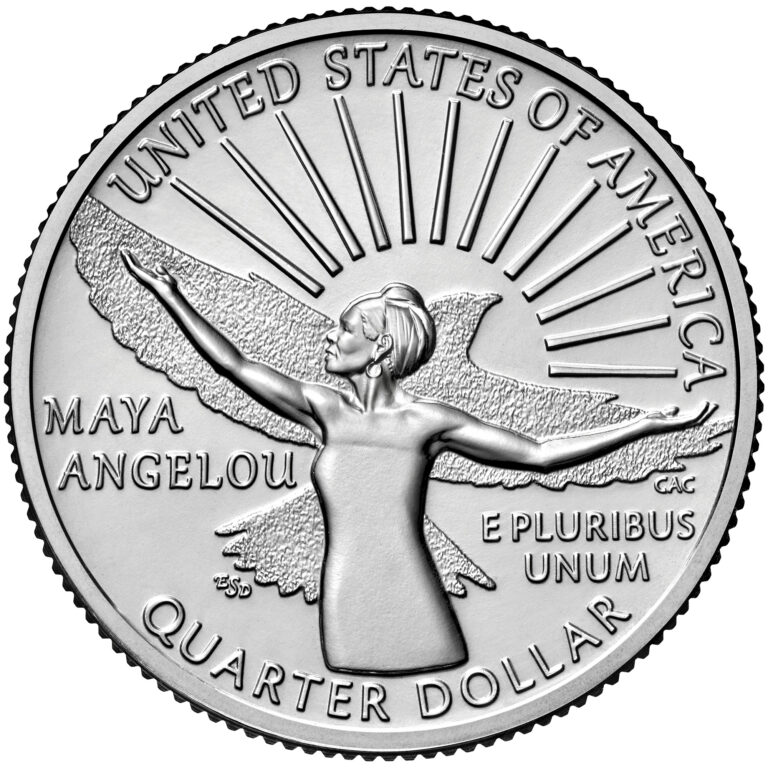
Dr. Sally Ride Quarter
Dr. Sally Ride was a physicist, pioneer in space exploration, and leader in science education. The quarter design depicts Dr. Ride next to a window on the space shuttle, inspired by her quote, “But when I wasn’t working, I was usually at a window looking down at Earth.”
“Dr. Ride had an opportunity to view our home, this planet, from a vantage point seen by so very few. All of human existence becomes contained in this marble, this coin, glowing in the vastness of space,” said Mint AIP Artist Elana Hagler. “An astronaut’s profession is so much about technical know-how, but it is also about courage, daring, and such rare moments of transcendent awe.”
Mint Medallic Artist Phebe Hemphill used the traditional process of clay and plaster to sculpt the portrait of Dr. Ride and used digital sculpting software to sculpt the other elements of the design.
“The use of the old techniques combined with the new digital process gave me the best tools to make a great coin,” said Hemphill. “I always enjoy sculpting portraits because they are such a challenge in very low relief sculpture.”
“Dr. Ride has always been an inspiration to me, and it was a phenomenal opportunity to play even a small part in the development of this coin,” said Design Manager Sullivan. “She was such an important figure to an entire generation of young women fascinated by science and space exploration.”
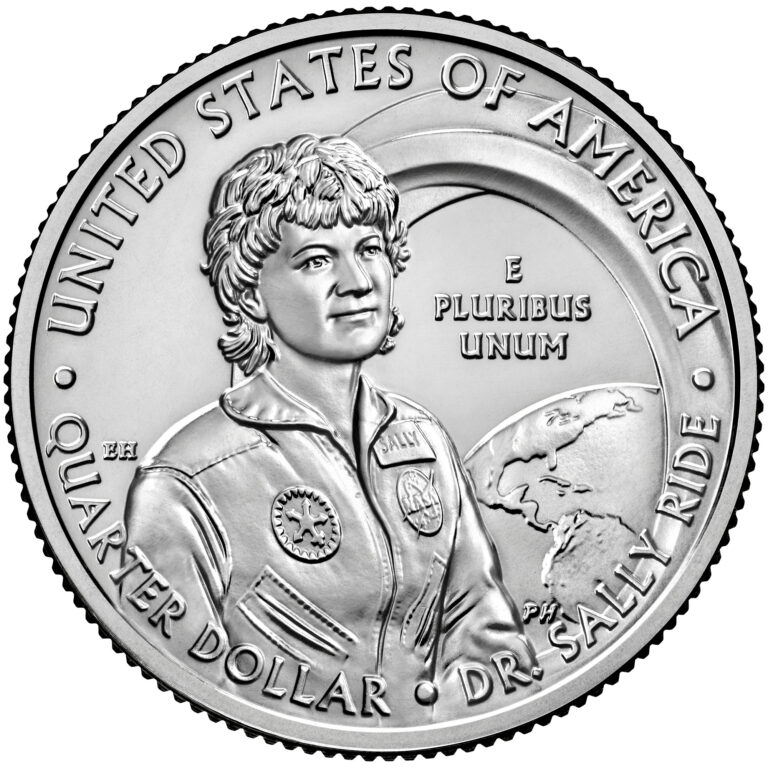
Wilma Mankiller Quarter
Wilma Mankiller was the first female Principal Chief of the Cherokee Nation. She worked tirelessly to revitalize the Cherokee Nation through extensive community development, education, and health care programs.
“Principal Chief Mankiller demonstrated that the power to change our communities is limited only by our vision. She saw her people as the source of hope for the
Cherokee Nation. She believed the strength of the community offered solutions to the challenges they were facing,” said the coin’s designer, Benjamin Sowards. In the coin design, Wilma Mankiller gazes resolutely towards the future. The wind is at her back, and she is wrapped in a traditional shawl. To her left is the seven-pointed star of the Cherokee Nation. “We pay close attention to every piece of symbolism to ensure the tribe is properly represented,” said Sullivan.
“The Wilma Mankiller sculpt was a nice challenge, because the viewer’s point of view is below her, and she is looking off into the distance,” said Hemphill. “The process of sculpting is like figuring out a puzzle with severe depth limitations.”
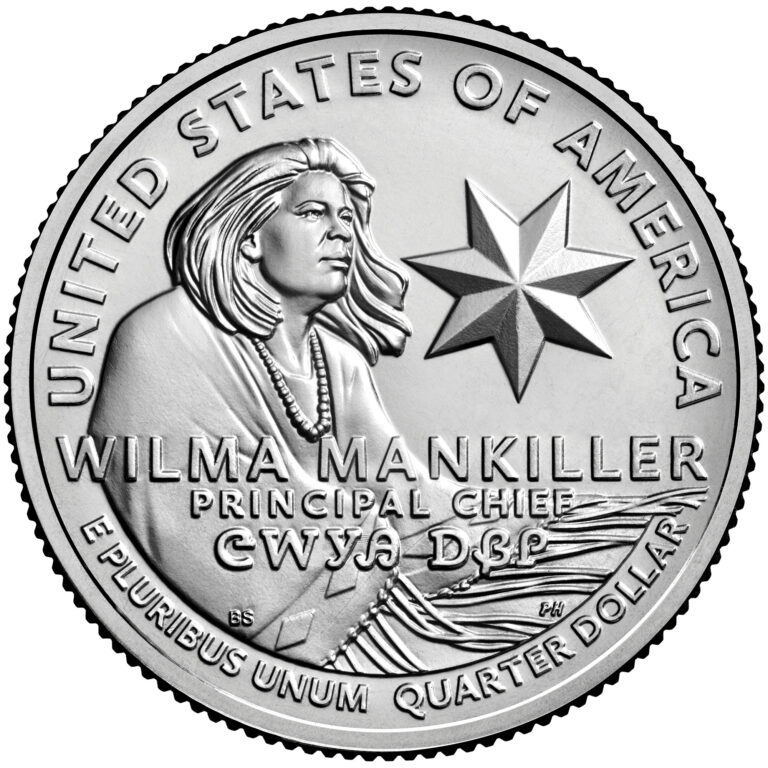
Nina Otero-Warren Quarter
“This quarter dollar design is composed of a portrait of Nina Otero-Warren, a powerful inscription, and a cluster of Yucca blossoms, the state flower of New Mexico. It recognizes Nina Otero-Warren’s influence as a New Mexico politician, educator, and suffragist in support of the ratification of the 19th Amendment,” said Mint AIP Artist Chris Costello, who drew on his background as a graphic designer, illustrator, and type designer to create the quarter design. “The Art Deco typography reflects America’s progressive mood during the early 20th century.”
“The inscription, ‘VOTO PARA LA MUJER’ [‘Votes for Women’], is a nod to Otero-Warren’s belief that the use of Spanish was critical in the New Mexico suffrage movement,” said Costello.
“Nina Otero-Warren’s commitment to the inclusion of the Spanish language in New Mexico’s suffrage movement brought a new dimension
and audience into the effort, said Mint Design Manager Pam Borer. “It was important to bring this element into the coin design to recognize its significance.”
“It is a privilege to bring forth the stories of these courageous women, especially for those who may not be as well-known as others,” added Borer, with reference to Otero-Warren, in particular.
Costello explains, “The portrait conveys Nina Otero-Warren’s quiet confidence, patience, and determination while advancing her human rights agenda as a Spanish-American woman in spite of the prevailing barriers confronting women in America.”
“It was a great honor to create this sculpture to memorialize an amazing woman, her incredible life, and her work moving humankind towards equality,” said Mint Medallic Artist Craig Campbell, who executed the sculpt for the quarter. “I believe the ripples of her legacy will be felt forever.”
“The design immortalizes a very courageous woman and is meant to inspire and inform all Americans of her impact on the nation,” said Costello.
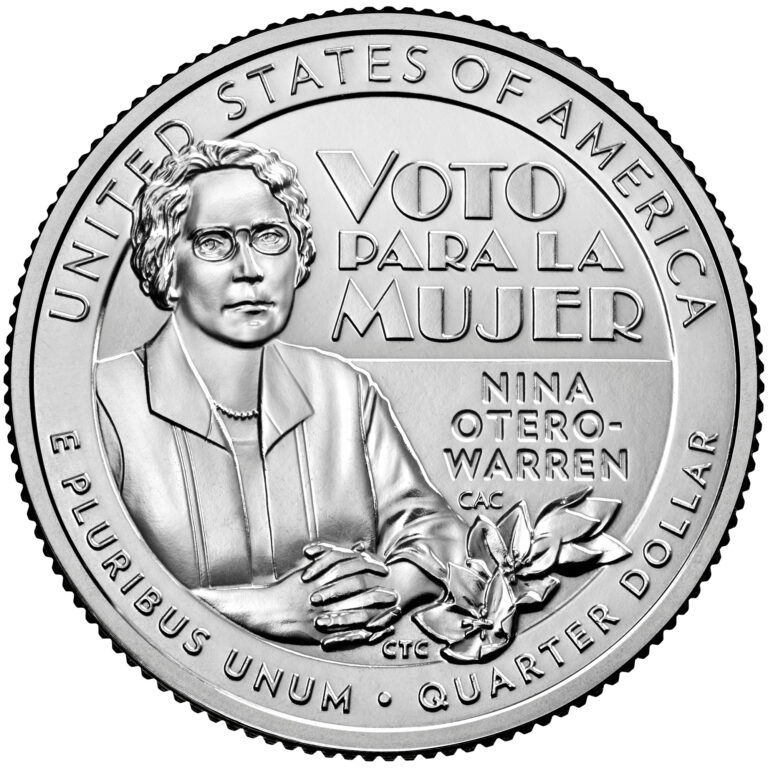
Anna May Wong Quarter
Anna May Wong was the first Chinese American film star in Hollywood and appeared in more than 60 movies throughout her career. In addition to her roles in black-and-white silent films, television, and plays, Wong landed a role in one of the first movies made in Technicolor.
“Many prominent actors from the ‘20s and ‘30s saw their names framed by lightbulbs on movie theater marquees, so I thought it made sense to feature Anna May
Wong in this way,” said Damstra about her coin design. “Along with the hard work, determination, and skill Anna May Wong brought to the profession of acting, I think it was her face and expressive gestures that really captivated movie audiences, so I included these elements next to her name.”
“I’m honored to have sculpted the design honoring iconic actress Anna May Wong,” said Mint Medallic Artist John McGraw. “Her forwardfacing portrait is reminiscent of a theatrical mask and added to the challenge when sculpting a portrait in such low relief.”
“Anna May Wong’s career as an actress provided an opportunity to develop designs in an occupation we haven’t explored often,” said Borer,
who managed the design.
Anna May Wong left a lasting legacy for Asian American women in the film industry. According to Borer, “The design recognizes Anna May Wong’s perseverance in pursuing significant roles that broke through the discrimination barriers of her time.”
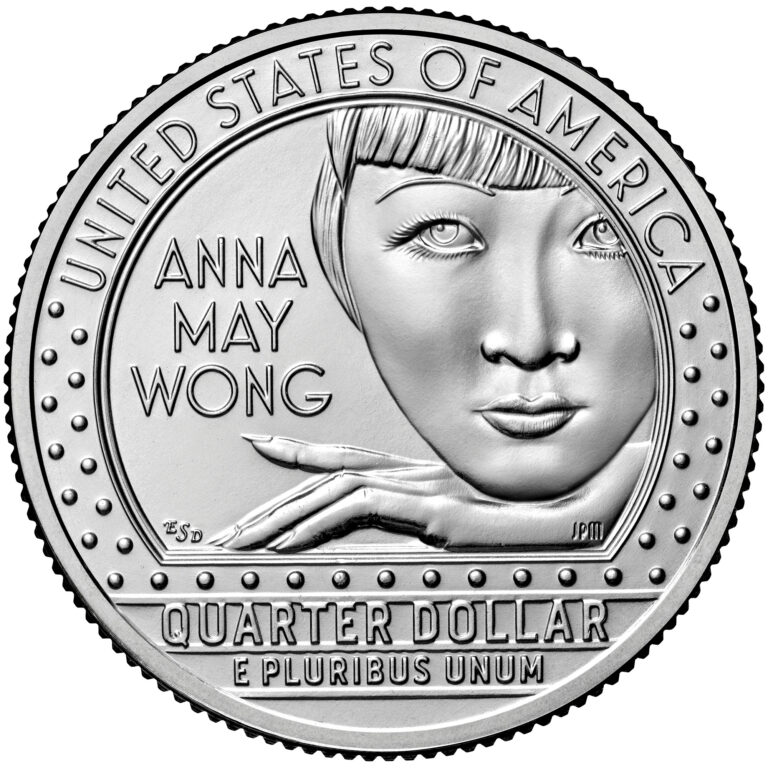
Laura Gardin Fraser and Common Obverse
All coins issued in the AWQ Program will bear a common obverse (commonly known as the “heads” side of a coin) designed and sculpted by Lauren Gardin Fraser, one of the most prolific female sculptors in the 20th century and the first woman to design a United States coin.
Fraser originally sculpted the portrait of George Washington to mark his 200th birthday. Her rendition was recommended for the 1932 quarter by the George Washington Bicentennial Committee and the Commission of Fine Arts, but then-Treasury Secretary Andrew W. Mellon ultimately selected the now-familiar design by John Flanagan instead. Starting in 2022, nearly a century later, Fraser’s design will be minted on billions of coins and used by millions of Americans as they conduct day-to-day transactions.
Fraser’s contributions span the art and numismatic worlds. In addition to the obverse featuring Washington, she designed the Alabama Centennial Half Dollar, 1922 Grant Memorial Gold Dollar and silver half dollar, and the 1925 Fort Vancouver Centennial Half Dollar. She also designed the Charles Lindbergh, George C. Marshall, and Benjamin Franklin Congressional Gold Medals and medals for the National Geographic Society, American Bar Association, and National Sculpture Society.
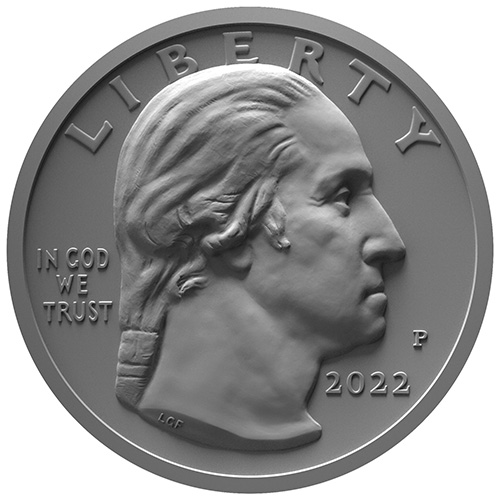
This article originally appeared in the winter 2021 issue of Clio, the magazine of the National Women's History Museum.
Tracy Scelzo-Chavez is a public affairs specialist at the United States Mint. She holds an MBA from Fordham University and an MA in communications from Johns Hopkins University.
